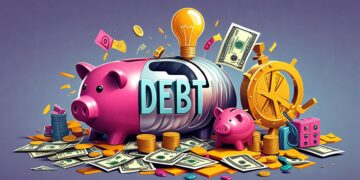How to Reduce Mortgage Costs and Save Money in the Long Run

Understanding Your Mortgage: Key Strategies to Cut Costs
For many Americans, committing to a mortgage is akin to embarking on a lifelong journey of financial obligation. Recognizing how to effectively manage this hefty expense is not just beneficial, but essential. Here, we delve deeper into the cornerstone strategies that can help you reduce mortgage costs, providing both clarity and actionable insights.
Interest Rates: The Power of Lower Rates
Interest rates play a pivotal role in determining your total mortgage cost. A seemingly small difference in rate can lead to thousands of dollars in savings over the life of the loan. For instance, a 30-year fixed-rate mortgage of $300,000 at 4.0% interest will accumulate $215,608 in interest payments. However, if you manage to secure a 3.0% rate instead, that number drops dramatically to $127,967.
Loan Term: Shortening Your Commitment
Harnessing Extra Payments
Incorporating extra payments can provide an effective method for reducing your mortgage balance. This approach can take many forms—whether contributing a little extra each month, making a single large payment annually, or even utilizing windfalls such as tax refunds. Not only does this lower the principal amount, but it also means you’ll pay less interest over time.
Refinancing: A Double-Edged Sword
Refinancing your mortgage can often lead to lower monthly payments, but it does come with its own set of considerations. Closing costs can consume a significant portion of the savings achieved, sometimes making refinancing not worthwhile for everyone. Thoroughly evaluating your current mortgage terms and comparing them with potential refinanced rates is crucial. Moreover, market fluctuations can also sway this decision, so staying informed is vital.
Factors Influencing Mortgage Costs
As you navigate the intricacies of your mortgage, understanding the factors that contribute to it is equally important. For instance, your credit score is instrumental—a score above 740 significantly increases your chances of landing a lower interest rate. On the flip side, a lower score may constrain your options. Similarly, a down payment of at least 20% can help you avoid private mortgage insurance (PMI) and ultimately lower your overall loan amount.
The Value of Shopping Around
One of the most effective ways to explore better financing deals is by shopping around for lenders. Different banks, credit unions, and online lenders may offer various terms and rates. By comparing these options diligently, you might uncover not only a lower interest rate but also better loan terms that align with your financial goals.
Engaging in these strategies doesn’t require a financial wizard. With a bit of research and strategic thinking, you can significantly enhance your mortgage management. Taking even small steps today can pave the way for substantial savings tomorrow, ultimately leading to greater financial stability and peace of mind.
CHECK OUT: Click here to explore more
Key Techniques for Saving on Your Mortgage
When it comes to navigating the world of mortgages, understanding the various techniques available can empower homeowners to make informed decisions that can save them substantial amounts in the long run. Here, we explore essential methods that can help you cut costs and improve your financial well-being.
Understanding Amortization
The concept of amortization is central to mortgage management. Simply put, amortization refers to the process of gradually paying off a loan through a series of scheduled payments. For homeowners, it’s crucial to understand how each payment is allocated between interest and principal repayment.
In the early years of your mortgage, a larger portion of your monthly payment goes towards interest rather than reducing the principal balance. As you progress, this shifts, and more of your payment starts to pay down the principal. Utilizing an amortization calculator can help visualize this process, allowing you to identify opportunities to make additional payments or adjust your payment schedule in a way that promotes equity growth.
Consider a Biweekly Payment Schedule
Another effective way to manage mortgage costs is by switching to a biweekly payment schedule. By dividing your monthly payment in half and paying that amount every two weeks, you can effectively make one extra payment each year. This results in paying down your mortgage faster and can save you thousands in interest payments over the loan’s lifetime.
- Example: A homeowner with a $300,000 mortgage at a 4.0% interest rate pays approximately $1,432 monthly. By switching to biweekly payments, they would end up paying about $1,063 every two weeks, accumulating an extra payment by year’s end.
- This extra annual payment reduces the principal faster, thereby decreasing interest costs.
The Importance of Maintaining a Good Credit Score
Your credit score is not only pivotal when initially securing a mortgage but also plays a significant role in future financial decisions. A higher credit score often translates to better mortgage rates, potentially saving you thousands over the loan’s lifespan. Regularly monitoring your credit report for issues and ensuring timely payments on existing debts are fundamental steps in maintaining a healthy score. A score above 740 typically qualifies you for the best rates; therefore, prioritizing your credit health should be a key financial goal.
Utilize Home Equity Wisely
As you make payments on your mortgage, your home builds equity. This valuable asset can be leveraged for various purposes, including opting for a cash-out refinance, which could allow you to access better rates or consolidate debts at lower interest. However, caution is advised; accumulating more debt against your home can be risky if not carefully managed. Be sure to consult with a financial advisor to discern the best course of action for your unique financial situation.
These strategies underscore the multifaceted approach to reducing mortgage costs. By understanding the nuances involved, homeowners can make empowered decisions that will not only alleviate current financial burdens but also pave the way for lasting savings. The path to financial victory often lies in the details, and a strategic approach today can unlock significant gains for tomorrow.
CHECK OUT: Click here to explore more
Advanced Strategies for Cutting Mortgage Expenses
While understanding the basic techniques for reducing mortgage costs is essential, exploring advanced strategies can unlock further potential savings. These methods not only address the immediate expenses of owning a home but also lay the groundwork for long-term financial health.
Shop for the Best Mortgage Rates
When it comes to mortgages, shopping around for the best rates can yield significant savings. Homebuyers often make the mistake of settling for the first offer presented to them, but mortgage rates can vary widely among lenders. Taking the time to obtain quotes from multiple lenders allows you to compare not only the interest rates but also the associated fees, such as closing costs and points. Even a modest reduction in interest rates can save you tens of thousands over a 30-year loan.
Additionally, consider utilizing online resources and mortgage brokers who can provide access to a broad array of lenders. Local banks and credit unions may also offer competitive rates, particularly for those with strong relationships or unique community programs.
Refinance When the Time is Right
Refinancing offers homeowners the opportunity to secure a lower interest rate, reduce their monthly payment, or switch from an adjustable-rate mortgage (ARM) to a fixed-rate mortgage. However, timing is critical. Ideally, you should consider refinancing when market conditions become favorable, such as when interest rates drop significantly—usually by at least 1% less than your current rate.
- A refinance may come with fees, so ensure you calculate the break-even point, which is the time it will take for your savings to surpass the costs of refinancing. For instance, if it costs $3,000 to refinance and you save $300 a month, your break-even point would be 10 months.
Make Extra Payments Strategically
In addition to biweekly payments, consider making extra payments towards your principal whenever possible. This not only accelerates the payoff process but also significantly reduces the total interest paid over the life of the loan. An additional $100 payment every month can shave years off your mortgage and save thousands in interest, especially if you start this practice early in the loan term.
Some lenders allow for additional payments without penalties, but it’s crucial to specify that these extra funds should go directly towards the principal. Failure to clarify could result in the lender applying the extra funds towards future interest instead of reducing the loan balance.
Use a Mortgage Points Strategy
Another avenue to consider is the strategic use of mortgage points. Points are fees paid directly to the lender at closing in exchange for a reduced interest rate. This option can be beneficial for homeowners who plan to stay in their homes for an extended period, as the lower monthly payment can accumulate substantial savings over time.
- For instance, paying one point (1% of the loan amount) to lower the rate by 0.25% can be a wise investment if the homeowner intends to keep their mortgage for ten years or more. Understanding your long-term plans can help you decide whether purchasing points makes sense.
Consider Government Programs
Finally, homeowners should explore government-backed programs designed to assist in mortgage management. Programs such as FHA, VA, and USDA loans come with specific benefits such as lower down payments or interest rates geared towards eligible buyers. These initiatives aim to make homeownership more accessible and affordable, especially for first-time buyers or those looking to refinance.
Connecting with a knowledgeable lender familiar with these programs can reveal options you might not have considered. By leveraging these advanced strategies, homeowners can optimize their mortgage experience, ensuring they maintain financial flexibility for future endeavors.
CHECK OUT: Click here to explore more
Conclusion
Reducing mortgage costs is not merely an initial step in homeownership; it is a vital strategy for long-term financial stability. By employing techniques such as shopping for the best mortgage rates and refinancing strategically, homeowners can effectively lower monthly payments, which translates into substantial savings over the life of their mortgage. Furthermore, embracing the practice of making extra payments towards the principal and understanding the intricacies of mortgage points can dramatically decrease the overall financial burden and shorten the repayment period.
Additionally, tapping into government-backed programs can open doors to favorable terms, helping those eligible to access lower down payments and interest rates designed to support sustainable homeownership. It’s essential to not only look at immediate savings but also to plan for the long-term impact of these decisions on your financial health.
Ultimately, financial literacy and proactive engagement with your mortgage should become integral components of your homeownership journey. By taking the time to explore all available options and staying informed about market trends, homeowners can unlock the potential for significant savings. Therefore, the prudent homeowner is not simply a buyer but a savvy financial strategist—one who is willing to seek out opportunities and make informed decisions that lead to enduring financial freedom. Consider delving deeper into these topics to refine your approach and enhance your potential for savings.

Linda Carter is a writer and financial expert specializing in personal finance and financial planning. With extensive experience helping individuals achieve financial stability and make informed decisions, Linda shares her knowledge on the Father Company platform. Her goal is to empower readers with practical advice and strategies for financial success.





